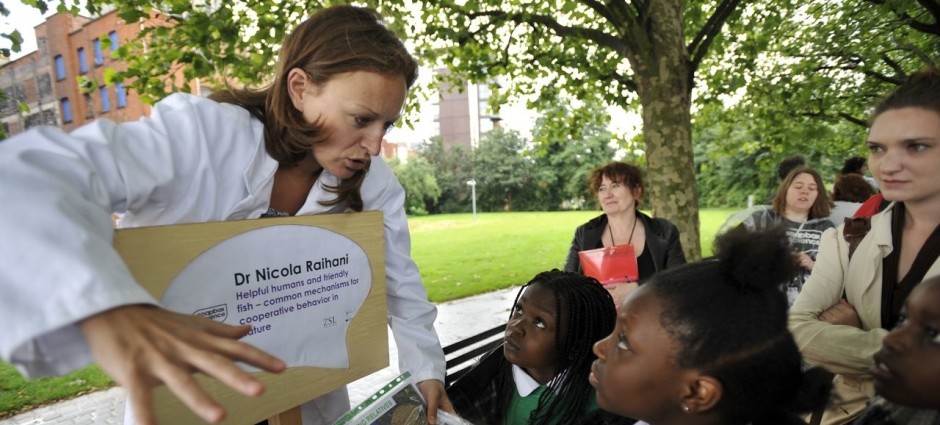 Eimear O’Hara (@Eimear_Ohara) is a PhD Student at NUI Galway, who is taking part in Soapbox Science Galway on 7th July with the talk: “Developing new materials for cleaner, greener and cheaper power generation”
Eimear O’Hara (@Eimear_Ohara) is a PhD Student at NUI Galway, who is taking part in Soapbox Science Galway on 7th July with the talk: “Developing new materials for cleaner, greener and cheaper power generation”
SS: How did you get to your current position?
 EO: My name is Eimear O’Hara and I am a PhD student in Mechanical Engineering at the National University of Ireland Galway. I did my undergraduate degree in the same field at NUI Galway. The mechanical engineering degree is one of the broadest courses you can choose and was closely linked with the biomedical course, as well as covering aspects of civil and computer programming. Some examples of the projects students do are shown in figures 1 – 3. The main focus is understanding how materials behave under different types of loads and the best way to design against failure. This meant that the areas you could work in are endless. After I finished my degree, I was offered the opportunity to do a research masters on characterising a new type of steel for power plants. I enjoyed this so much I applied for more funding so I could continue my research as a PhD student. (Figure 1. A bridge built out of pasta by first year engineering students. The better the design, the heavier the weight it can lift.)
EO: My name is Eimear O’Hara and I am a PhD student in Mechanical Engineering at the National University of Ireland Galway. I did my undergraduate degree in the same field at NUI Galway. The mechanical engineering degree is one of the broadest courses you can choose and was closely linked with the biomedical course, as well as covering aspects of civil and computer programming. Some examples of the projects students do are shown in figures 1 – 3. The main focus is understanding how materials behave under different types of loads and the best way to design against failure. This meant that the areas you could work in are endless. After I finished my degree, I was offered the opportunity to do a research masters on characterising a new type of steel for power plants. I enjoyed this so much I applied for more funding so I could continue my research as a PhD student. (Figure 1. A bridge built out of pasta by first year engineering students. The better the design, the heavier the weight it can lift.)
SS: What, or who, inspired you to get a career in science?
EO: In secondary school, I took up Engineering for my Leaving Certificate and haven’t really looked back since. I loved the hands-on and practical aspects of it, while also learning why certain materials behaved the way they do. Having a great teacher also helped a lot!
 SS: What is the most fascinating aspect of your research/work?
SS: What is the most fascinating aspect of your research/work?
EO: I am working on characterising a new type of steel to use in power plants that can operate at higher temperatures and loads – basically making electricity production cheaper, with less harmful emissions, and trying to make it easier to incorporate renewable energy sources. Because this is a new material, there are so many unexplored avenues so my work covers a broad range of things from testing the material at high temperature to looking at why it failed under a microscope to creating computer models of all those things. Although it can be challenging and sometimes not very clear why things are happening, it means everything I do adds to the knowledge base for this material and can help future designers improve even more. (Figure 2. First year engineering students are given a gearbox and asked to design and build a truck from household items that can carry the heaviest weight in the fastest time.)
SS: What attracted you to Soapbox Science in the first place?
EO: I have represented the mechanical engineering department at many open days and one of the most common questions I get is ‘what exactly is mechanical engineering?’ I saw this as a great opportunity to teach people of all ages and backgrounds that mechanical engineering is the broadest degree you can choose in the engineering field – ranging from aircraft design to biomedical applications even to computer coding.
SS: Sum up in one word your expectations for the event.
EO: Exciting!
SS: If you could change one thing about the scientific culture right now, what would it be?
EO: The majority of schools don’t offer metalwork or engineering as a subject. The first time some students learn about engineering as a university degree can often be late into their secondary school education, so workshops within schools may be a great way to improve people’s understanding of the subject and the many options it provides for future careers.
 SS: What would be your top recommendation to a woman studying for a PhD and considering pursuing a career in science?
SS: What would be your top recommendation to a woman studying for a PhD and considering pursuing a career in science?
EO: A PhD can be very isolating and generally there are few people, if any, that will be working in the same area as you, so having a good support network within your office, or outside of it, can help get through tough times. In terms of a future career, a PhD provides you with so many options that the hardest thing can be figuring out what to do next, but you definitely won’t be short of options! (Figure 3. The Galway Energy Efficient Car (GEEC) built and designed by engineering students and raced internationally.)
